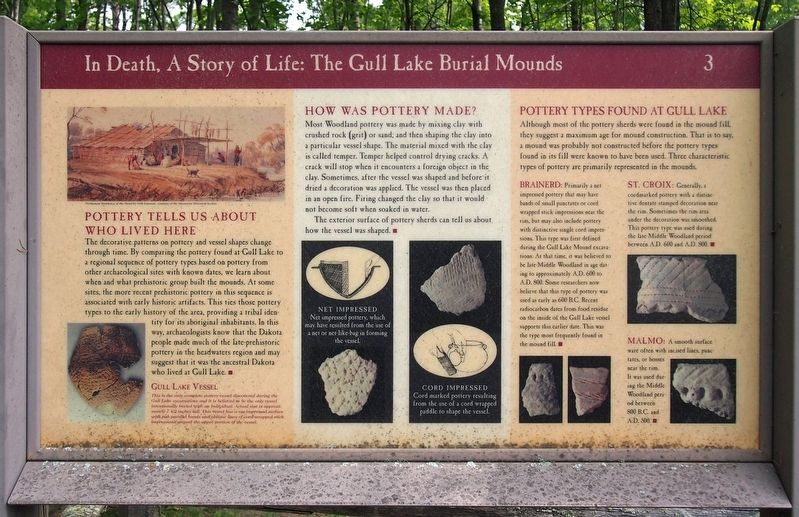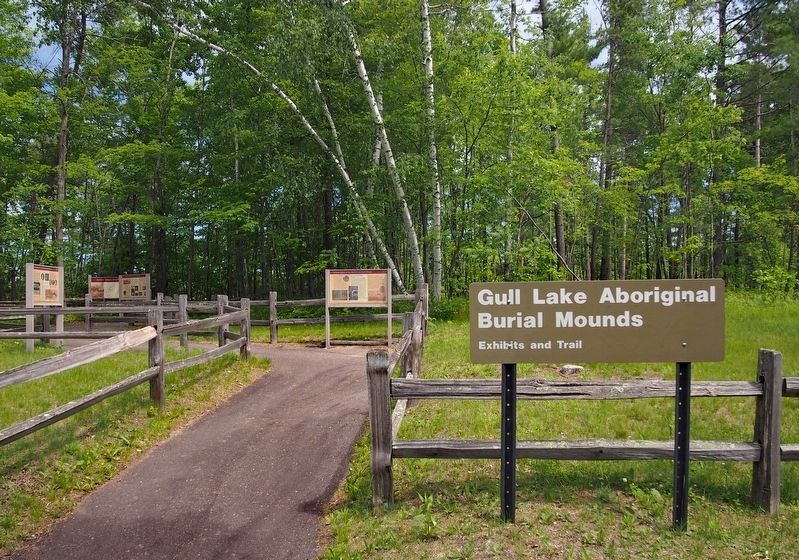East Gull Lake in Cass County, Minnesota — The American Midwest (Upper Plains)
In Death, a Story of Life: The Gull Lake Burial Mounds
Inscription.
Pottery Tells Us About Who Lived Here
The decorative patterns on pottery and vessel shapes change through time. By comparing the pottery found at Gull Lake to a regional sequence of pottery types based on pottery from other archaeological sites with known dates, we learn about when and what prehistoric group built the mounds. At some sites, the more recent prehistoric pottery in this sequence is associated with early historic artifacts. This ties those pottery types to the early history of the area, providing a tribal identity for its aboriginal inhabitants. In this way, archaeologists know that the Dakota people made much of the late-prehistoric pottery in the headwaters region and may suggest that it was the ancestral Dakota who lived at Gull Lake.
Gull Lake Vessel
This is the only complete pottery vessel discovered during the Gull Lake excavations and it is believed to be the only vessel intentionally buried with an individual. Actual size is approximately 7 1/2 inches tall. This vessel has a net impressed surface with two parallel bands and oblique lines of cord-wrapped-stick impressions around the upper portion of the vessel.
How Was Pottery Made?
Most Woodland pottery was made by mixing clay with crushed rock (grit) or sand, and then shaping the clay into a particular vessel shape. The material mixed with the clay is called temper. Temper helped control drying cracks. A crack will stop when it encounters a foreign object in the clay. Sometimes, after the vessel was shaped and before it dried a decoration was applied. The vessel was then placed in an open fire. Firing changed the clay so that it would not become soft when soaked in water.
The exterior surface of pottery sherds can tell us about how the vessel was shaped.
Net Impressed
Net impressed pottery, which may have resulted from the use of a net or net-like-bag in forming the vessel.
Cord Impressed
Cord marked pottery resulting from the use of a cord wrapped paddle to shape the vessel.
Pottery Types Found at Gull Lake
Although most of the pottery sherds were found in the mound fill, they suggest a maximum age for mound construction. That is to say, a mound was probably not constructed before the pottery types found in its fill were known to have been used. Three characteristic types of pottery are primarily represented in the mounds.
Brainerd: Primarily a net impressed pottery that may have bands of small punctates or cord wrapped stick impressions near the rim, but may also include pottery with distinctive single cord impressions. This type was first defined during the Gull Lake Mound excavations.
At that time, it was believed to be late-Middle Woodland in age dating to approximately A.D. 600 to A.D. 800. Some researchers now believe that this type of pottery was used as early as 600 B.C. Recent radiocarbon dates from food residue on the inside of the Gull Lake vessel supports this earlier date. This was the type most frequently found in the mound fill.
St. Croix: Generally, a cordmarked pottery with a distinctive dentate stamped decoration near the rim. Sometimes the rim area under the decoration was smoothed. This pottery type was used during the late-Middle Woodland period between A.D. 600 and A.D. 800.
Malmo: A smooth surface ware often with incised lines, punctates, or bosses near the rim. It was used during the Middle Woodland period between 800 B.C. and A.D. 500.
Erected by U.S. Army Corps of Engineers. (Marker Number 3.)
Topics. This historical marker is listed in these topic lists: Anthropology & Archaeology • Cemeteries & Burial Sites • Native Americans. A significant historical year for this entry is 600 CE.
Location. 46° 24.665′ N, 94° 21.136′ W. Marker is in East Gull Lake, Minnesota, in Cass County. Marker can be reached from Gull Lake Dam Road (County Road 125) 0.1 miles south of Gull Lake Lane, on the left when traveling east. The marker is in Gull Lake Recreation Area, at the beginning of the trail through the Gull Lake Aboriginal Burial Mounds. Touch for map. Marker is at or near this postal address: 1197 Gull Lake Dam Rd, Brainerd MN 56401, United States of America. Touch for directions.
Other nearby markers. At least 8 other markers are within 9 miles of this marker, measured as the crow flies. In Death, A Story of Life: The Gull Lake Burial Mounds (here, next to this marker); a different marker also named In Death, a Story of Life: The Gull Lake Burial Mounds (a few steps from this marker); Geology of Minnesota (approx. 3 miles away); The Present Location of the Lake Hubert Depot (approx. 7.7 miles away); Lake Hubert Depot (approx. 7.7 miles away); Reconciliation (approx. 8 miles away); All Veterans Memorial (approx. 8.1 miles away); Former Northern Pacific Railway Water Tower (approx. 8.1 miles away). Touch for a list and map of all markers in East Gull Lake.
Credits. This page was last revised on December 3, 2023. It was originally submitted on October 16, 2022, by McGhiever of Minneapolis, Minnesota. This page has been viewed 130 times since then and 15 times this year. Last updated on December 2, 2023, by McGhiever of Minneapolis, Minnesota. Photos: 1, 2. submitted on October 16, 2022, by McGhiever of Minneapolis, Minnesota. • J. Makali Bruton was the editor who published this page.

